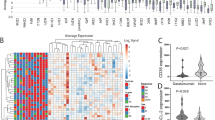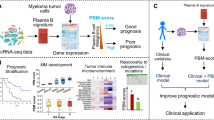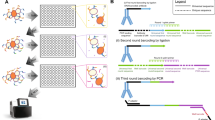Abstract
Depletion of disease below the levels detected by sensitive minimal residual disease (MRD) assays is associated with prolonged survival in chronic lymphocytic leukaemia (CLL). Flow cytometric MRD assays are now sufficiently sensitive and rapid to guide the duration of therapy in CLL, but generally rely on assessment of CD20 expression, which cannot be accurately measured during and after therapeutic approaches containing rituximab. The aim of this study was to use analytical software developed for microarray analysis to provide a systematic approach for MRD flow assay development. Samples from CLL patients (n=49), normal controls (n=21) and other B-lymphoproliferative disorders (n=12) were assessed with a panel of 66 antibodies. The DNA-Chip analysis program was used to identify discriminating antibodies, with hierarchical cluster analysis to identify complementary combinations. An iterative process was used: increasing numbers of patients were assessed with smaller, more targeted antibody panels until a highly specific combination (CD81/CD22/CD19/CD5) was identified. This combination was as sensitive and specific as previously reported assays and potentially applicable to blood and marrow samples from patients treated with current therapeutic approaches including rituximab. This approach to the identification of disease-specific antibody combinations for MRD analysis is readily applicable to a variety of haematological disorders.
This is a preview of subscription content, access via your institution
Access options
Subscribe to this journal
Receive 12 print issues and online access
$259.00 per year
only $21.58 per issue
Buy this article
- Purchase on Springer Link
- Instant access to full article PDF
Prices may be subject to local taxes which are calculated during checkout





Similar content being viewed by others
References
Byrd JC, Peterson BL, Morrison VA, Park K, Jacobson R, Hoke E et al. Randomized phase 2 study of fludarabine with concurrent versus sequential treatment with rituximab in symptomatic, untreated patients with B-cell chronic lymphocytic leukemia: results from Cancer and Leukemia Group B 9712 (CALGB 9712). Blood 2003; 101: 6–14.
Schulz H, Klein SK, Rehwald U, Reiser M, Hinke A, Knauf WU et al. Phase 2 study of a combined immunochemotherapy using rituximab and fludarabine in patients with chronic lymphocytic leukemia. Blood 2002; 100: 3115–3120.
Wendtner CM, Ritgen M, Schweighofer CD, Fingerle-Rowson G, Campe H, Jager G et al. Consolidation with alemtuzumab in patients with chronic lymphocytic leukemia (CLL) in first remission--experience on safety and efficacy within a randomized multicenter phase III trial of the German CLL Study Group (GCLLSG). Leukemia 2004; 18: 1093–1101.
Thieblemont C, Bouafia F, Hornez E, Dumontet C, Tartas S, Antal D et al. Maintenance therapy with a monthly injection of alemtuzumab prolongs response duration in patients with refractory B-cell chronic lymphocytic leukemia/small lymphocytic lymphoma (B-CLL/SLL). Leukemia Lymphoma 2004; 45: 711–714.
Milligan DW, Fernandes S, Dasgupta R, Davies FE, Matutes E, Fegan CD et al. Results of the MRC pilot study show autografting for younger patients with chronic lymphocytic leukemia is safe and achieves a high percentage of molecular responses. Blood 2005; 105: 397–404.
Bottcher S, Ritgen M, Pott C, Bruggemann M, Raff T, Stilgenbauer S et al. Comparative analysis of minimal residual disease detection using four-color flow cytometry, consensus IgH-PCR, and quantitative IgH PCR in CLL after allogeneic and autologous stem cell transplantation. Leukemia 2004; 18: 1637–1645.
Keating MJ, O'Brien S, Albitar M, Lerner S, Plunkett W, Giles F et al. Early results of a chemoimmunotherapy regimen of fludarabine, cyclophosphamide, and rituximab as initial therapy for chronic lymphocytic leukemia. J Clin Oncol 2005; 23: 4079–4088.
Wierda W, O'Brien S, Wen S, Faderl S, Garcia-Manero G, Thomas D et al. Chemoimmunotherapy with fludarabine, cyclophosphamide, and rituximab for relapsed and refractory chronic lymphocytic leukemia. J Clin Oncol 2005; 23: 4070–4078.
Bosch F, Ferrer A, Lopez-Guillermo A, Gine E, Bellosillo B, Villamor N et al. Fludarabine, cyclophosphamide and mitoxantrone in the treatment of resistant or relapsed chronic lymphocytic leukaemia. Br J Haematol 2002; 119: 976–984.
Provan D, Bartlett-Pandite L, Zwicky C, Neuberg D, Maddocks A, Corradini P et al. Eradication of polymerase chain reaction-detectable chronic lymphocytic leukemia cells is associated with improved outcome after bone marrow transplantation. Blood 1996; 88: 2228–2235.
Rawstron AC, Kennedy B, Evans PA, Davies FE, Richards SJ, Haynes AP et al. Quantitation of minimal disease levels in chronic lymphocytic leukemia using a sensitive flow cytometric assay improves the prediction of outcome and can be used to optimize therapy. Blood 2001; 98: 29–35.
Moreton P, Kennedy B, Lucas G, Leach M, Rassam SM, Haynes A et al. Eradication of minimal residual disease in B-cell chronic lymphocytic leukemia after alemtuzumab therapy is associated with prolonged survival. J Clin Oncol 2005; 23: 2971–2979.
Esteve J, Villamor N, Colomer D, Cervantes F, Campo E, Carreras E et al. Stem cell transplantation for chronic lymphocytic leukemia: different outcome after autologous and allogeneic transplantation and correlation with minimal residual disease status. Leukemia 2001; 15: 445–451.
Cragg MS, Bayne MB, Tutt AL, French RR, Beers S, Glennie MJ et al. A new anti-idiotype antibody capable of binding rituximab on the surface of lymphoma cells. Blood 2004; 104: 2540–2542.
Cragg MS, Bayne MC, Illidge TM, Valerius T, Johnson PW, Glennie MJ . Apparent modulation of CD20 by rituximab: an alternative explanation. Blood 2004; 103: 3989–3990;author reply 3990–3991.
Jilani I, O'Brien S, Manshuri T, Thomas DA, Thomazy VA, Imam M et al. Transient down-modulation of CD20 by rituximab in patients with chronic lymphocytic leukemia. Blood 2003; 102: 3514–3520.
Sanchez ML, Almeida J, Vidriales B, Lopez-Berges MC, Garcia-Marcos MA, Moro MJ et al. Incidence of phenotypic aberrations in a series of 467 patients with B chronic lymphoproliferative disorders: basis for the design of specific four-color stainings to be used for minimal residual disease investigation. Leukemia 2002; 16: 1460–1469.
Ibrahim S, Jilani I, O'Brien S, Rogers A, Manshouri T, Giles F et al. Clinical relevance of the expression of the CD31 ligand for CD38 in patients with B-cell chronic lymphocytic leukemia. Cancer 2003; 97: 1914–1919.
Morabito F, Mangiola M, Stelitano C, Deaglio S, Callea V, Malavasi F . Simultaneous expression of CD38 and its ligand CD31 by chronic lymphocytic leukemia B-cells: anecdotal observation or pathogenetic hypothesis for the clinical outcome? Haematologica 2003; 88: 354–355.
Damle RN, Ghiotto F, Valetto A, Albesiano E, Fais F, Yan XJ et al. B-cell chronic lymphocytic leukemia cells express a surface membrane phenotype of activated, antigen-experienced B lymphocytes. Blood 2002; 99: 4087–4093.
Mateo V, Lagneaux L, Bron D, Biron G, Armant M, Delespesse G et al. CD47 ligation induces caspase-independent cell death in chronic lymphocytic leukemia. Nat Med 1999; 5: 1277–1284.
Barrena S, Almeida J, Yunta M, Lopez A, Fernandez-Mosteirin N, Giralt M et al. Aberrant expression of tetraspanin molecules in B-cell chronic lymphoproliferative disorders and its correlation with normal B-cell maturation. Leukemia 2005; 19: 1376–1383.
Zucchetto A, Sonego P, Degan M, Bomben R, Dal Bo M, Russo S et al. Signature of B-CLL with different prognosis by Shrunken centroids of surface antigen expression profiling. J Cell Physiol 2005; 204: 113–123.
Li C, Wong WH . Model-based analysis of oligonucleotide arrays: expression index computation and outlier detection. Proc Natl Acad Sci USA 2001; 98: 31–36.
Maynadie M, Picard F, Husson B, Chatelain B, Cornet Y, Le Roux G et al. Immunophenotypic clustering of myelodysplastic syndromes. Blood 2002; 100: 2349–2356.
Acknowledgements
This work was supported by the Leukaemia Research Fund and Yorkshire Cancer Research.
Author information
Authors and Affiliations
Corresponding author
Rights and permissions
About this article
Cite this article
Rawstron, A., de Tute, R., Jack, A. et al. Flow cytometric protein expression profiling as a systematic approach for developing disease-specific assays: identification of a chronic lymphocytic leukaemia-specific assay for use in rituximab-containing regimens. Leukemia 20, 2102–2110 (2006). https://doi.org/10.1038/sj.leu.2404416
Received:
Revised:
Accepted:
Published:
Issue Date:
DOI: https://doi.org/10.1038/sj.leu.2404416
Keywords
This article is cited by
-
Measurable residual disease in chronic lymphocytic leukemia: expert review and consensus recommendations
Leukemia (2021)
-
A complementary role of multiparameter flow cytometry and high-throughput sequencing for minimal residual disease detection in chronic lymphocytic leukemia: an European Research Initiative on CLL study
Leukemia (2016)
-
EuroFlow antibody panels for standardized n-dimensional flow cytometric immunophenotyping of normal, reactive and malignant leukocytes
Leukemia (2012)
-
Immune recovery after fludarabine–cyclophosphamide–rituximab treatment in B-chronic lymphocytic leukemia: implication for maintenance immunotherapy
Leukemia (2010)
-
Standardized MRD flow and ASO IGH RQ-PCR for MRD quantification in CLL patients after rituximab-containing immunochemotherapy: a comparative analysis
Leukemia (2009)



